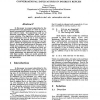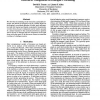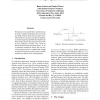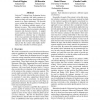ACL
1992
14 years 18 days ago
1992
The three-tiered discourse representation defined in (Luperfoy, 1991) is applied to multimodal humancomputer interface (HCI) dialogues. In the applied system the three tiers are (...
ACL
1992
14 years 18 days ago
1992
I In this paper we present algorithms for the interpretation and generation of a kind of particularized conversational implicature occurring in certain indirect replies. Our algori...
ACL
1994
14 years 23 days ago
1994
We show that in modeling social interaction, particularly dialogue, the attitude of obligation can be a useful adjunct to the popularly considered attitudes of belief, goal, and i...
COLING
2000
14 years 24 days ago
2000
We compare the potential of two classes of linear and hierarchical models of discourse to determine co-reference links and resolve anaphors. The comparison uses a corpus of thirty...
NAACL
2003
14 years 24 days ago
2003
We introduce two probabilistic models that can be used to identify elementary discourse units and build sentence-level discourse parse trees. The models use syntactic and lexical ...
NAACL
2004
14 years 25 days ago
2004
CriterionSM Online Essay Evaluation Service includes a capability that labels sentences in student writing with essay-based discourse elements (e.g., thesis statements). We descri...
ECIS
2004
14 years 25 days ago
2004
Discursive-based analysis of organizations is not new in the field of interpretive social studies. Since not long ago have information systems (IS) studies also shown a keen inter...
NAACL
2007
14 years 26 days ago
2007
Previous work on discourse parsing has mostly relied on surface syntactic and lexical features; the use of semantics is limited to shallow semantics. The goal of this thesis is to...
LREC
2008
14 years 26 days ago
2008
We present the second version of the Penn Discourse Treebank, PDTB-2.0, describing its lexically-grounded annotations of discourse s and their two abstract object arguments over t...
LREC
2008
14 years 26 days ago
2008
This paper presents a corpus-based study of the discourse connective in contrast. The corpus data are drawn from the British National Corpus (BNC) and are analyzed at the levels o...




